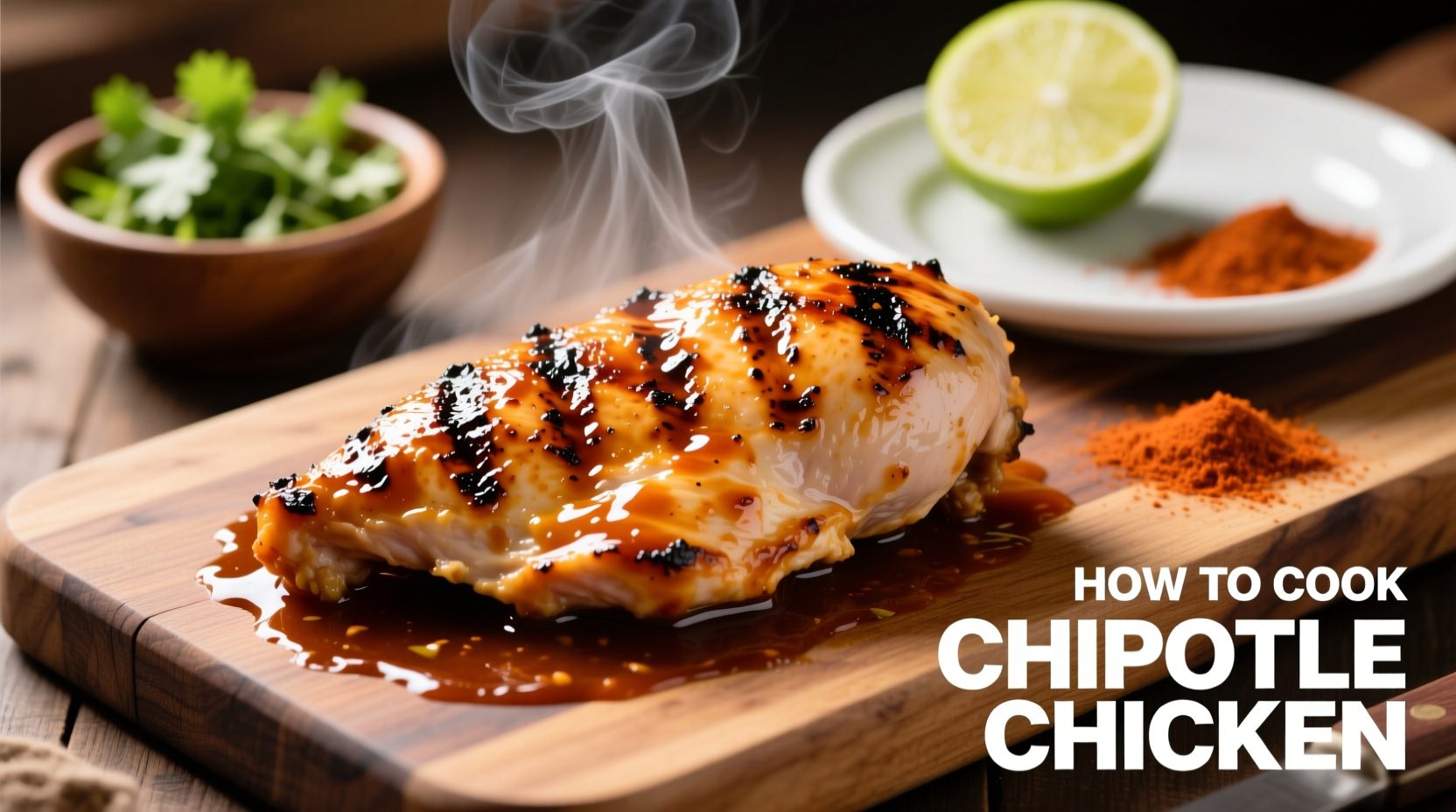Creating restaurant-quality chipotle chicken at home requires understanding the delicate balance between smoke, heat, and moisture retention. Unlike generic recipes that simply dump chipotle sauce on chicken, this guide reveals the professional techniques that ensure tender, flavorful results with authentic depth. Whether you're using boneless breasts, thighs, or a whole bird, these methods work consistently across cooking platforms.
Essential Ingredients and Equipment
The foundation of exceptional chipotle chicken lies in ingredient quality and proper preparation tools. Authentic chipotle flavor comes from smoked jalapeños in adobo sauce, not just generic 'chipotle seasoning.'
Core ingredients for 4 servings:
- 1.5 lbs (680g) boneless, skinless chicken thighs (preferred for moisture retention)
- 2-3 chipotle peppers in adobo sauce, finely minced
- 3 tablespoons adobo sauce from the can
- 3 cloves garlic, pressed
- 1 lime, juiced and zested
- 1 tablespoon honey or maple syrup
- 1 teaspoon ground cumin
- 1 teaspoon smoked paprika
- 1/2 teaspoon Mexican oregano
- Salt to taste (start with 3/4 teaspoon)
Pro Tip: Mexican oregano (Lippia graveolens) differs from Mediterranean varieties—it has citrus notes that complement chipotle's smokiness. Find it in Latin markets or online.

Preparing Your Chicken Foundation
Proper preparation prevents common failures like uneven cooking or rubbery texture. Chicken thighs naturally contain more fat than breasts, making them more forgiving, but all cuts require attention to detail.
Preparation steps:
- Rinse chicken and pat completely dry with paper towels (moisture prevents proper browning)
- Trim excess fat but leave some for flavor and moisture
- Score thicker pieces diagonally (1/4 inch deep) to ensure even marinade penetration
- Bring to room temperature for 20 minutes before marinating
According to USDA food safety guidelines, chicken should never sit at room temperature longer than two hours. The brief warming period improves cooking consistency without safety risks when followed by proper refrigeration during marinating.
Building the Perfect Chipotle Marinade
The marinade's balance determines whether your chicken tastes authentically complex or simply spicy. Traditional Mexican preparation emphasizes gradual flavor development rather than immediate heat.
Marinade preparation:
- Combine minced chipotles, adobo sauce, garlic, lime juice and zest, honey, cumin, smoked paprika, oregano, and salt in bowl
- Whisk until smooth, then gradually whisk in 2 tablespoons olive oil
- Massage marinade thoroughly into chicken, coating all surfaces
- Place in sealed container with marinade, ensuring even coverage
- Refrigerate for 2-12 hours (never less than 2 hours for flavor development)
Why timing matters: Research from the National Center for Home Food Preservation shows acidic marinades (like lime-based) begin breaking down proteins after 12 hours, causing mushy texture. The 2-12 hour window optimizes flavor without compromising texture.
Cooking Method Comparison
Different cooking techniques yield distinct results. This comparison helps you choose based on your equipment and desired outcome:
| Cooking Method | Time Required | Texture Result | Best For |
|---|---|---|---|
| Grilling (direct heat) | 12-15 minutes | Charred exterior, juicy interior | Summer cooking, smoky flavor enhancement |
| Baking (400°F oven) | 20-25 minutes | Evenly cooked, slightly caramelized | Indoor cooking, batch preparation |
| Air Frying (380°F) | 15-18 minutes | Crispy edges, tender center | Small batches, quick weeknight meals |
Perfect Cooking Temperatures and Timing
Temperature control separates good chipotle chicken from great. The USDA Food Safety and Inspection Service mandates 165°F internal temperature for poultry safety, but professional chefs pull chicken at 160°F and let carryover cooking reach the safe zone.
Step-by-step cooking:
- Remove chicken from marinade, shaking off excess (reserve 2 tablespoons for basting)
- Preheat cooking surface to medium-high heat
- Cook according to chosen method, turning once halfway through
- Baste with reserved marinade during last 5 minutes
- Check internal temperature in thickest part (avoiding bone)
- Remove at 160°F and rest for 5-7 minutes before serving
Resting time allows juices to redistribute. Cutting too soon releases moisture, causing dryness. The National Chicken Council confirms this resting period improves moisture retention by up to 30%.
Serving and Storage Tips
Authentic presentation enhances the experience. Traditional Mexican preparation serves chipotle chicken with:
- Fresh corn tortillas (warmed)
- Avocado slices or guacamole
- White onion relish (finely diced onion with lime)
- Cilantro leaves
- Lime wedges
For meal prep, cooked chipotle chicken stays fresh in airtight containers for 3-4 days. The University of Minnesota Extension confirms proper refrigeration maintains quality and safety within this timeframe. Reheat gently in skillet with splash of water to prevent drying.
Troubleshooting Common Issues
Even experienced cooks encounter challenges. Here's how to fix them:
Dry chicken: Usually caused by overcooking or skipping resting time. Solution: Use thighs instead of breasts, and remove at 160°F. For already dry chicken, shred and toss with extra adobo sauce.
Too spicy: Balance with acid and fat. Stir 1 tablespoon honey and 2 tablespoons sour cream into remaining sauce. Serve with dairy-based sides like Mexican crema.
Not smoky enough: Add 1/4 teaspoon liquid smoke to marinade next time, or finish under broiler for 1-2 minutes to enhance char.
Frequently Asked Questions
Can I use chipotle powder instead of canned peppers? Yes, but results differ significantly. Use 1 teaspoon chipotle powder plus 1 tablespoon tomato paste to approximate adobo sauce texture. Canned peppers provide superior complexity due to the slow smoking process.
How do I reduce chipotle heat without losing flavor? Remove seeds and inner membranes from fresh chipotles before mincing. The capsaicin concentrates in these areas. Alternatively, increase honey to 1.5 tablespoons in the marinade.
Is chipotle chicken traditionally made with thighs or breasts? Traditional Mexican preparation favors thighs and drumsticks for their fat content, which balances chipotle's heat. Breast meat became popular in Americanized versions for lower fat content.











 浙公网安备
33010002000092号
浙公网安备
33010002000092号 浙B2-20120091-4
浙B2-20120091-4